You'll master outdoor baking by implementing these essential moisture control secrets. Position your solar oven perpendicular to the sun and line it with black construction paper for ideal heat. Monitor dew point readings and reduce liquid ingredients by 25% on humid days. Keep one latch loose for steam venting, and use a dark tea towel to absorb excess moisture. Wipe condensation regularly from glass surfaces, and protect your setup with strategic wind blocks. Maintain dough temperature between 75-78°F, and adjust hydration levels based on weather conditions. Consider high-protein flour for better moisture control, as it handles up to 70% hydration. These foundational tips just scratch the surface of expert outdoor baking techniques.
Moisture-Proof Your Solar Oven Setup
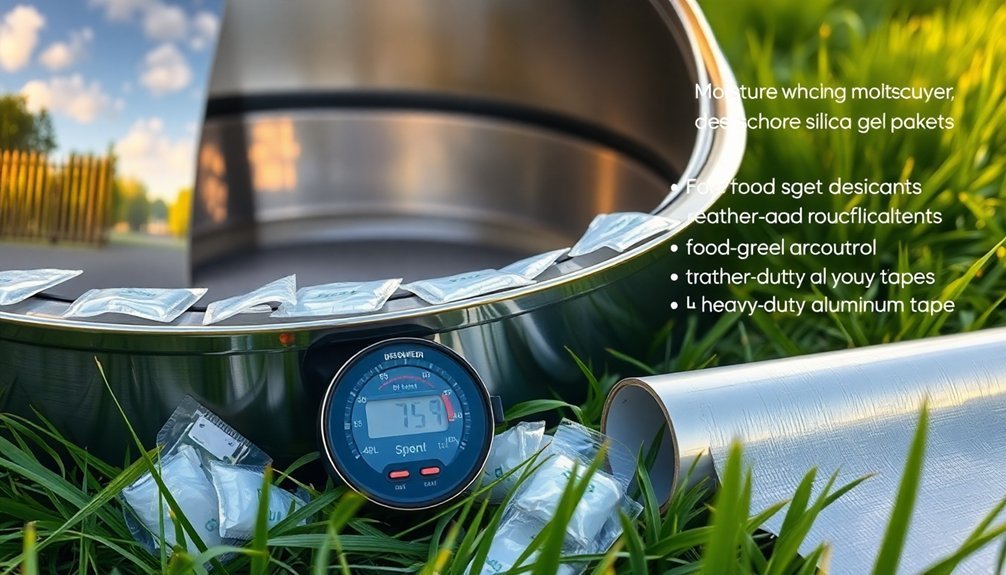
When setting up your solar oven, proper moisture control can make the difference between perfectly cooked food and a soggy disappointment. Start by positioning your oven perpendicular to the sun's rays and line it with black construction paper for ideal heat absorption. Without direct sunlight, your oven will experience rapid heat loss.
To manage moisture effectively, you'll need a strategic approach. Leave one latch slightly loose or insert a small matchstick between the glass and oven edge to create a steam vent. You don't want to trap too much moisture inside.
When using cooking vessels, reduce liquid amounts by 1/4 to 1/2 cup since solar ovens retain more moisture than conventional ovens. Keep pot lids slightly loose to allow steam escape while maintaining heat.
Remember to wipe condensation from the glass quickly when checking your food to maintain ideal sunlight penetration.
Weather Analysis Before Outdoor Baking
You'll want to check your local dew point forecast, as higher readings indicate more atmospheric moisture that can affect your outdoor baking results.
Keep an eye on wind patterns since moist air currents can bring unexpected humidity to your baking area, even on seemingly clear days.
Understanding these weather indicators lets you adjust your recipes and baking times accordingly, much like you'd do in an indoor kitchen during humid conditions. On particularly humid days, remember to reduce liquid ingredients by about 25% to maintain proper dough consistency.
Monitoring Local Dew Points
Successfully monitoring local dew points before outdoor baking can make the difference between perfectly baked goods and disappointing results. You'll need to check dew point readings regularly using high-precision sensors to adjust your baking approach. When dew points rise above 80°F, your doughs will spread faster and require longer bake times, while readings below 30°F signal drier conditions needing moisture adjustments. Just like industrial furnace monitoring, continuous measurement systems provide reliable data to prevent quality issues.
| Dew Point | Impact | Your Action |
|---|---|---|
| Above 80°F | Very muggy, fast spreading | Use chilled ingredients |
| 60-79°F | Moderately humid | Reduce liquid slightly |
| Below 30°F | Dry, quick moisture loss | Add extra moisture |
Keep your sensors protected from contaminants and extreme conditions to guarantee accurate readings. For precise monitoring, consider using sensors with sintered metal filters and multiple output options that integrate with your monitoring system.
Tracking Wind Moisture Patterns
Understanding wind moisture patterns plays a critical role in outdoor baking success. When wind carries moisture from nearby water sources or vegetation, it can greatly impact your baking results. You'll need to adjust your recipes accordingly to maintain consistent quality.
Watch for wind direction and speed, as these factors can bring unexpected humidity changes to your outdoor baking area. Using a wind screen for stability can help protect your baking setup from disruptive air currents. On days with moisture-laden winds, you'll want to reduce liquid ingredients by approximately 25% and gradually add them back until you reach the right consistency.
Keep your dry ingredients in sealed containers, and consider storing them in a cooler to prevent moisture absorption.
Consider setting up windbreaks to protect your baking station, and monitor how different wind patterns affect your dough's consistency throughout the day.
Steam Management During Solar Cooking
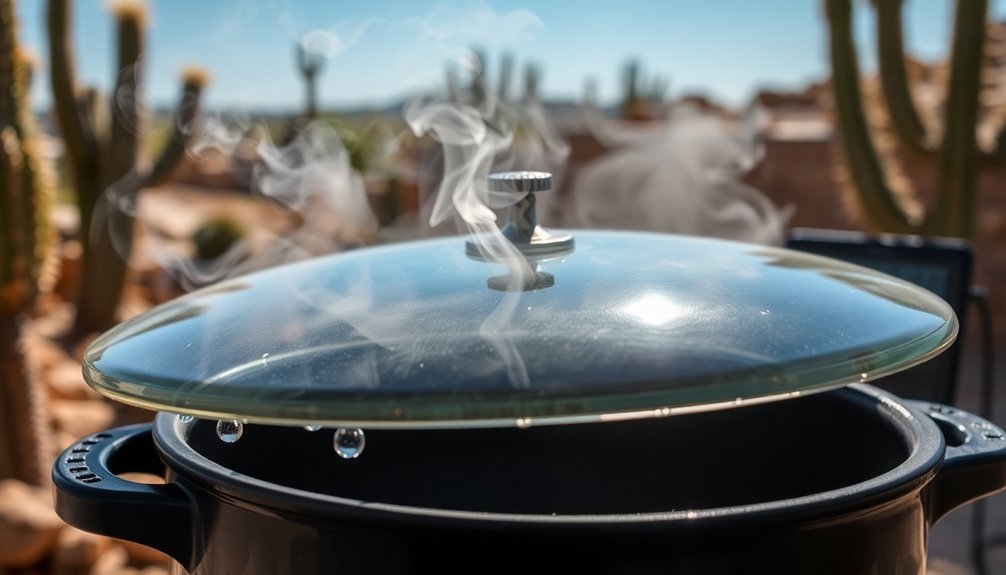
While cooking with a solar oven offers an eco-friendly approach to outdoor baking, managing steam levels is essential for achieving excellent results.
You'll want to create strategic ventilation by leaving a few latches unhooked or placing a small twig between the cover and box. This simple technique prevents excessive moisture buildup while maintaining ideal cooking temperatures.
Choose dark-colored cookware with lids, such as Granite Ware, to enhance heat absorption and distribute moisture evenly.
Pre-heat your solar cooker for 15-20 minutes and avoid opening the cover frequently. For effective steam control, position your cooker in a sheltered spot to protect it from strong winds, and regularly wipe condensation from the cover.
When baking items like bread or cakes, cook in batches to prevent steam accumulation and maintain consistent results.
Humidity Monitoring Tools and Techniques
Modern humidity monitoring tools transform outdoor baking from guesswork into a precise science.
You'll want to invest in RHT series sensors that offer ±1.5% accuracy for humidity and ±0.1°C for temperature readings. These sensors feature IP66-rated stainless steel housings, perfect for withstanding outdoor elements.
Look for devices with multiple output options and real-time monitoring capabilities. You'll benefit from displays that show both temperature and relative humidity, plus track MAX/MIN data points.
Mount your sensor using the wall-hanging design, but remember to take into account dwell time based on your cooking temperature and airflow patterns.
With proper humidity monitoring, you'll achieve better texture and rise in your baked goods, control crust development, and maintain ideal moisture levels throughout the baking process.
Natural Moisture Barriers While Baking
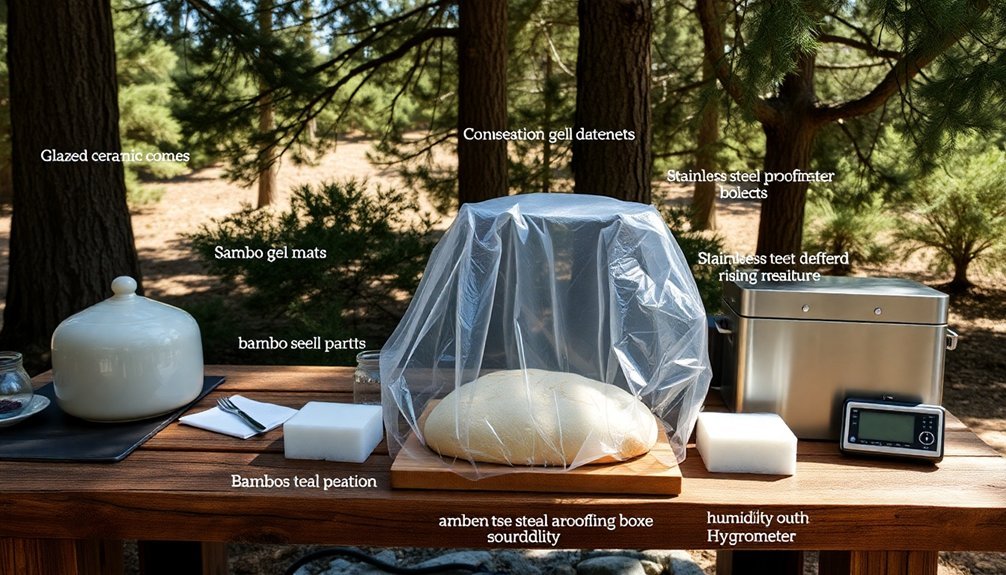
Creating effective moisture barriers in outdoor baking requires strategic material choices and proper ventilation techniques.
When building your outdoor baking space, you'll want to take into account using cedar for its natural moisture resistance, especially if you're in a humid climate. Unlike spruce or aspen, cedar doesn't require an air gap to stay dry.
For maximum moisture control, you'll need to implement proper ventilation strategies. Install foil non-bubble wrap as a vapor barrier, as it's more effective than other materials.
If you're using woods like spruce or aspen, make sure you create adequate air gaps for drying. Remember that most moisture enters through capillary action or air leaks rather than diffusion.
In cold climates, place your vapor barriers on the warm side of insulation, while in hot, humid areas, position them on the cool side.
Seasonal Adjustments for Outdoor Baking
Beyond setting up proper moisture barriers, successful outdoor baking requires adapting to nature's ever-changing conditions. You'll need to adjust your techniques based on seasonal challenges to maintain ideal moisture levels and achieve perfect results.
| Season | Challenge | Solution |
|---|---|---|
| Winter | Slow fermentation | Use warmer water, protect dough with tight lids |
| Summer | Heat control | Preheat grill 25°F higher, minimize lid opening |
| High Humidity | Excess moisture | Reduce leavening, use chilled ingredients |
When humidity's high, you'll want to increase bake times and adjust your recipe ratios. In dry conditions, do the opposite – shorter bake times and more liquid in your recipes. For summer grilling, stick to aluminum or cast iron pans, and keep that lid closed to maintain consistent temperatures. During winter, focus on creating warm, cozy environments for your dough to thrive.
Dough Hydration for Solar Success
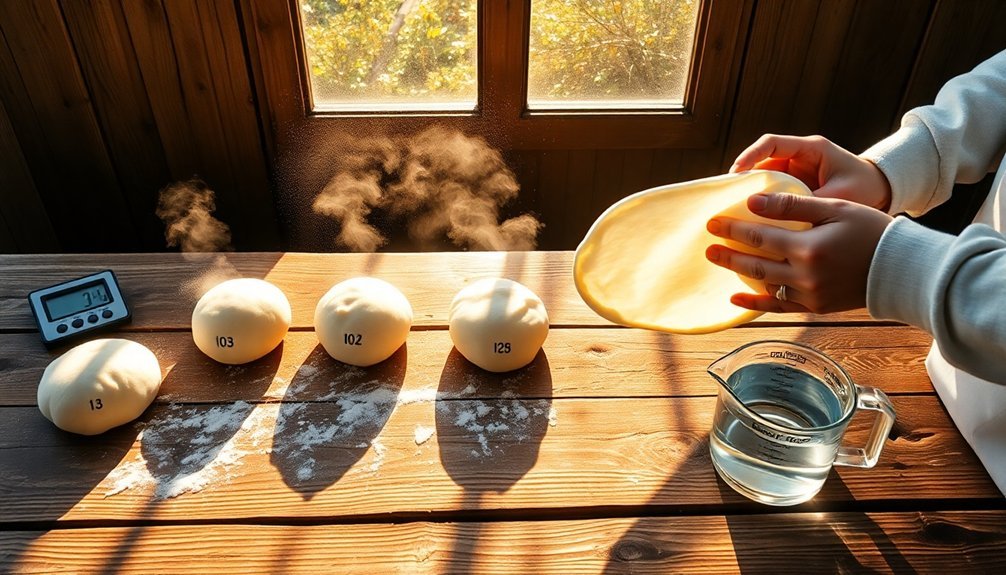
When you're baking in the sun, you'll need to closely monitor your dough's absorption rate to prevent over-hydration from ambient humidity and heat exposure.
Your dough's temperature will greatly affect how quickly it takes up moisture, so you should adjust your water-to-flour ratio downward by 5-10% from your standard recipe.
Control these variables by starting with cooler water and keeping your ingredients shaded until mixing time.
Dough Absorption Rate Control
Understanding how your dough absorbs moisture can make or break your outdoor baking success. When baking outside, you'll need to account for your flour's unique absorption capacity. American flours typically absorb more water than European varieties, so adjust your ratios accordingly.
Start by weighing your ingredients precisely with a kitchen scale. If you're using strong flour with high protein content, you can safely increase hydration levels up to 70%. For weaker flours, keep hydration lower to maintain control.
Mix with wet hands and let the dough rest for 30-60 minutes to reduce stickiness. When working with high-hydration doughs outdoors, use a folding technique rather than traditional kneading.
Remember that additional ingredients like salt, sugar, or milk powder will affect your dough's final moisture level.
Temperature Impact on Hydration
Temperature plays a pivotal role in managing dough hydration for outdoor baking success. When you're baking in warmer conditions, your dough will feel softer and stickier than usual, even at normal hydration levels. You'll need to adjust your recipe accordingly to maintain control.
To master outdoor dough hydration, you'll want to keep your dough temperature between 75°F and 78°F for best results. If you're working in hot weather, consider reducing your hydration levels and using cold water to offset ambient heat.
You can calculate your desired dough temperature (DDT) by factoring in your flour, levain, and environmental temperatures.
Remember that cooler temperatures make your dough feel stiffer and more manageable, while heat accelerates fermentation and increases stickiness. Use a reliable thermometer to monitor these conditions precisely.
Water-to-Flour Ratio Adjustments
Building on temperature's influence, precise water-to-flour ratios form the backbone of successful outdoor baking. You'll need to adapt your hydration levels based on environmental conditions to achieve best results.
| Hydration Level | Best Uses | Key Benefits |
|---|---|---|
| Low (55-60%) | Crusty rolls | Crispier texture |
| Medium (60-70%) | Basic breads | Balanced structure |
| High (70-80%) | Artisan loaves | Better oven spring |
| Very high (80%+) | Ciabatta | Maximum airiness |
When baking outdoors, you'll want to start with slightly lower hydration than usual, as environmental moisture can affect your dough. At higher elevations, increase your water content by 5-10% to compensate for the drier air. Remember to adjust gradually – you can always add more water, but you can't remove it once it's mixed in.
Controlling Condensation in Solar Ovens
When cooking in a solar oven, managing condensation is essential for maintaining ideal temperature and visibility. You'll need to balance steam release with heat retention to guarantee peak cooking conditions.
Try leaving one latch loose on your oven's glass cover or placing a small wooden skewer between the glass and frame to create a controlled vent. If you're cooking vegetables or rice, reduce the recipe's liquid content by ¼ to ½ cup to minimize steam production.
For persistent condensation, drape a dark tea towel over your covered pot to absorb excess moisture.
If your glass becomes completely fogged, you can quickly open the door for 2-3 seconds or wipe it with a cloth. Just remember that frequent venting will affect your cooking temperature, so use this method sparingly.
Wind Protection and Moisture Balance
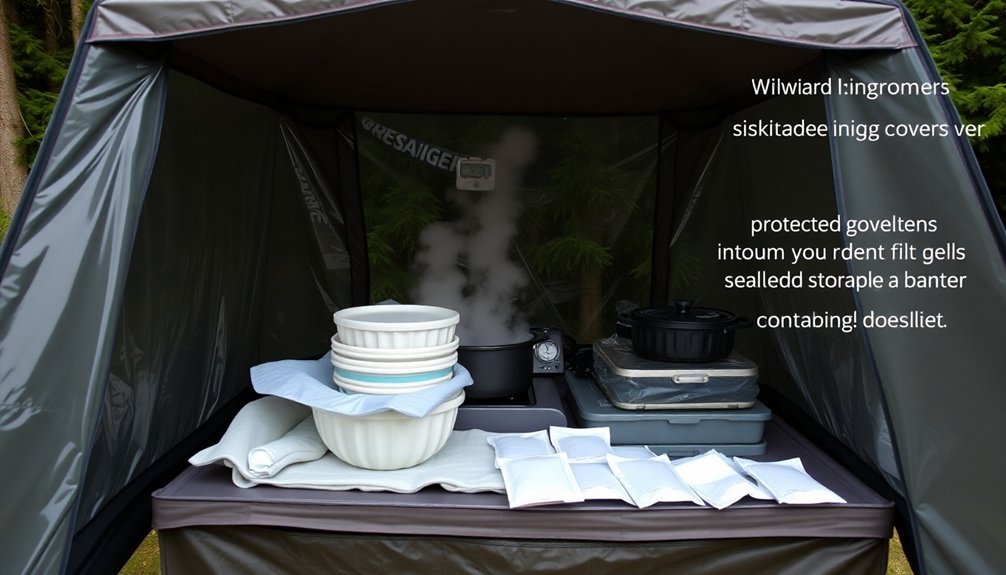
Properly shielding your outdoor cooking area from wind plays an essential role in maintaining consistent temperatures and moisture levels.
You'll want to set up durable carbon steel or aluminum alloy wind blocks around your cooking space, ensuring they're securely anchored to prevent tipping.
When you protect your baking area from wind, you're not just maintaining steady heat – you're also creating an environment that preserves vital moisture in your dough.
Wind can quickly dry out your baked goods' surface, affecting their texture and rise.
Position your wind shields to fully enclose the cooking area while leaving enough space for proper ventilation.
This setup will help you maintain ideal humidity levels, especially important for yeast-based recipes.
You'll find that wind protection results in more consistent baking results and reduced cooking time.
Temperature-Humidity Relationship Mastery
The complex interplay between temperature and humidity stands at the heart of successful outdoor baking.
You'll need to master this relationship to achieve that perfect crust and texture when baking in the great outdoors. Just like indoor ovens, your outdoor setup's humidity affects heat transfer and moisture retention in your dough.
- When you notice rising humidity levels, expect slower heat transfer and delayed crust formation – perfect for keeping your bread soft and allowing proper rise.
- During humid conditions, you won't need as much steam injection, as nature's doing some of the work for you.
- If it's exceptionally dry, you'll want to create artificial humidity using water pans or controlled steam to prevent your baked goods from drying out too quickly.
Remember to adjust your baking time and temperature based on these humidity variations.
Frequently Asked Questions
How Does Altitude Affect Moisture Levels in Outdoor Solar Baking?
At higher altitudes, you'll notice increased moisture loss since liquids evaporate faster due to lower atmospheric pressure. Your baked goods will dry out quicker, and you'll need more liquid in recipes to compensate.
Can Uv-Protective Covers Impact Humidity Control in Solar Ovens?
Yes, UV-protective covers like Lexan will help you manage humidity by preventing moisture loss while protecting against heat damage. You'll notice better temperature control and less condensation compared to standard covers.
What Role Do Different Baking Stone Materials Play in Moisture Retention?
You'll find different stones affect moisture differently: cordierite absorbs and wicks moisture away, FibraMent provides even baking without significant moisture draw, while stoneware actively pulls moisture from your food to create crispy crusts.
How Do Electromagnetic Fields Influence Moisture Distribution During Outdoor Baking?
When you're baking outdoors, electromagnetic fields agitate water molecules, creating uniform heat distribution. They'll penetrate your dough deeply, causing faster moisture loss from the center and quicker setting of the crumb structure.
Does Moonlight Affect Overnight Moisture Levels in Outdoor Baking Setups?
You can't rely on moonlight to affect moisture levels in your outdoor baking. There's no scientific evidence that lunar phases influence dough moisture – focus instead on controlling humidity and temperature for consistent results.
In Summary
Master these moisture control secrets, and you'll transform your outdoor baking game. Remember to check weather forecasts, use proper ventilation, and maintain ideal humidity levels in your solar oven. By applying these techniques, you're not just baking – you're creating perfect results regardless of outdoor conditions. Keep experimenting with different moisture barriers and dough hydration levels until you've found your perfect formula.

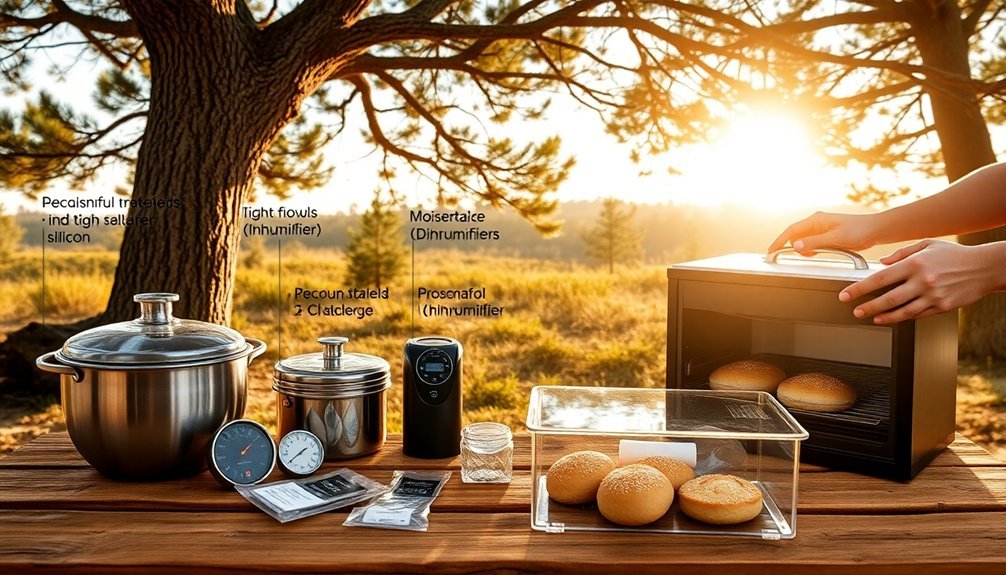



Leave a Reply